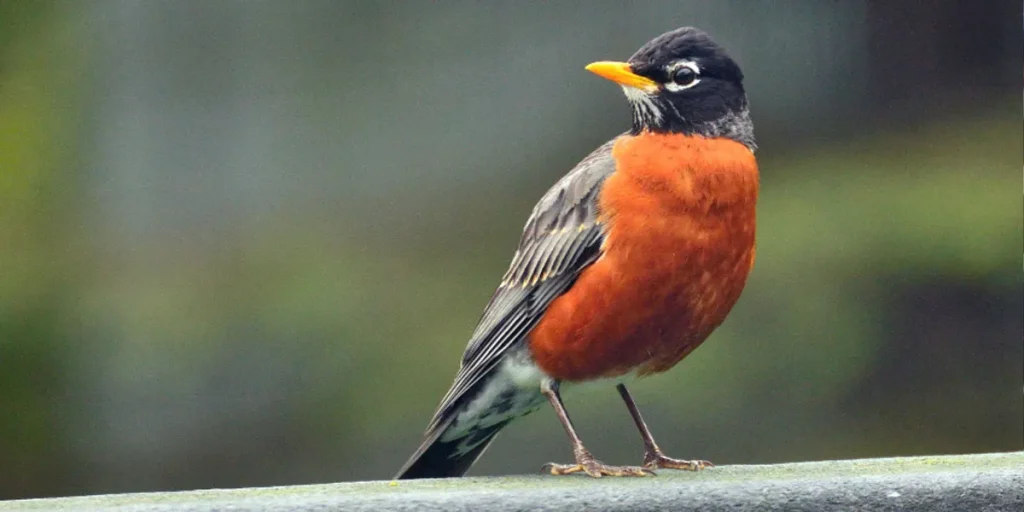A robin typically weighs about 2.7 ounces (77 grams). This small bird is a favorite among birdwatchers and gardeners.
Robins are a common sight in many parts of the world, often identified by their orange-red breasts and melodious songs.
Despite their lightweight, robins are sturdy birds, known for their agility and the ability to adapt to various environments, ranging from woodlands to urban areas.
Their presence often signifies the onset of spring, and their diet consists of insects, fruits, and worms, which contributes to their role in ecosystems as pest controllers and seed dispersers.
Robins are not just charming birds; they play a crucial role in maintaining the health of our gardens and natural landscapes.
Their average weight is an interesting fact that adds to our understanding of these feathered friends’ adaptability and survival strategies.
Tiny But Mighty: The Weight Of A Robin
The American Robin is a familiar sight in gardens and on lawns. Small in size, these birds pack a punch with their energetic lifestyle.
Often symbolizing the arrival of spring, robins display surprising strength for their seemingly delicate frames.
Learn just how much they weigh and how this compares to other feathered friends.
Variances In Robin Weights
Not all robins tip the scales the same way. Age and diet play key roles. A healthy robin can weigh between 2.7 to 3.0 ounces (77 to 85 grams). Let’s break down the factors.
- Seasons: Weight fluctuates with changing seasons.
- Age: Younger birds may weigh less.
- Sex: Males are slightly heavier.
Robins in colder regions might gain a bit extra to withstand the chill. Summer months, conversely, often see lighter birds ready for flight.
Comparing The Robin To Other Birds
| Bird Species | Average Weight |
|---|---|
| House Sparrow | 0.85 to 1.4 ounces |
| Blue Jay | 2.5 to 3.5 ounces |
| European Starling | 2.1 to 3.4 ounces |
Compared to these friends, the robin’s weight is just right for its size. It sits comfortably in the middle – not too heavy, not too light. This balances agility with durability out in the wild.
Robins are wonders of nature that demonstrate size isn’t everything. Despite being lightweight, these birds are resilient, adapting to different climates and environments. Their weight may seem small, but it’s perfect for survival.
Feathered Factors: What Affects A Robin’s Weight

Understanding the various factors that influence a robin’s weight opens a window to their fascinating natural world.
From diet to seasons, each aspect plays a vital role in the cheerful chirping bird’s life.
Dietary Influences On Weight
Like us, a robin’s diet has a direct impact on its weight. Consider the following points:
- Insect-rich diets lead to healthier birds, especially during breeding season.
- Fruits and berries are essential for energy but can contribute to weight gain.
- Variety in food sources is key for a balanced weight.
A robust robin can indicate good health, while a drop in weight might raise a red flag about its well-being.
Seasonal Weight Changes
Seasonal shifts mark significant changes in a robin’s weight:
| Season | Weight Influence |
|---|---|
| Spring | Weight increases due to abundant food. |
| Summer | Maintenance or slight increase with plenty of insects. |
| Fall | Weight gain as robins prep for migration. |
| Winter | Possible weight loss due to scarce resources. |
In preparation for migration, robins tend to bulk up, while milder winters can mean less dramatic weight changes. Each season plays a distinct role, shaping the overall health of these birds.
How Ornithologists Weigh Robins?
Measuring Up: How Ornithologists Weigh Robins is a fascinating dive into the science behind bird study.
Ornithologists, or bird scientists, work meticulously to record the weight of these feathered creatures.
This vital data aids in understanding bird health, migratory patterns, and behavior. The American Robin, a bird often spotted hopping across lawns, typically has a weight that ornithologists are keen to track.
Tools Of The Trade
Key equipment is essential for ornithologists to accurately weigh robins. They use:
- High-precision scales: These sensitive instruments can measure slight weight differences.
- Measuring cups: For smaller birds, sometimes contained cups are used to keep them still.
- Handling bags: Soft bags prevent birds from injury and stress during weighing.
Best Practices For Accurate Measurements
Ornithologists follow strict guidelines to ensure the weights they record are accurate:
- They calibrate scales before use to ensure precision.
- Robins are weighed at the same time of day to minimize variations from feeding.
- They handle birds gently to reduce stress which can affect weight.
- Multiple readings ensure consistency in the recorded data.
These methods help ornithologists gather the most reliable weight data on robins, adding to our understanding of these birds.
Weight Growth In Robins

Discovering the growth journey of a robin makes for a fascinating subject, especially when exploring how their weight increases from eggs to fully grown adults.
Robins, known for their beautiful melodies and iconic red breasts, follow a captivating growth trajectory.
Let’s delve into the different stages of a robin’s development, highlighting the key milestones in their weight gain from the moment they crack through their shells to their mature phase.
The Tiny Beginnings: Hatchling Weights
Robins hatch from their eggs as tiny, dependent creatures. At hatchling stage, these birds are featherless and blind, requiring the warmth and security of their nest.
A single robin egg, before the emergence of the hatchling, weighs about 5.5 grams. Upon hatching, they don’t weigh much more.
It’s truly remarkable how these birds start their lives from such a modest beginning.
- Newborn robin average weight: 5.5 – 6.0 grams
- Featherless and blind at birth
- Entirely dependent on parents for warmth and food
The Adolescent Phase: Weight Gain Milestones
As robins transition from dependent hatchlings to fledgling birds ready to leave the nest, their weight undergoes a significant increase.
This phase is critical as the birds develop their muscles and feathers. During the first days of life, robin chicks can double their weight in just a couple of days.
By the end of their first week, a robin’s weight is usually nearing 30 grams—nearly six times their initial weight!
| Age | Average Weight |
|---|---|
| Day 1 | 5.5 – 6.0 grams |
| Day 3 | 10 – 12 grams |
| Day 7 | 25 – 30 grams |
By two weeks, a robin’s weight will typically reach 40 – 50 grams, a stark contrast to its weight at birth. Their weight gain is part of their preparation for survival outside the nest.
Robins continue to gain weight and grow until they reach adulthood, by which point they’ll weigh anywhere from 56 to 85 grams, ready to take flight and join the skies.
Importance Of Weight Monitoring
The humble robin, with its distinctive red breast, is more than a symbol of the changing seasons.
Understanding the weight of this tiny songbird provides vital insights into its health and the broader health of the ecosystem.
Monitoring the weight of robins goes beyond simple measurement. It is an essential tool for gaining a deeper understanding of the well-being and survival of the species.
Indicators Of Health And Well-being
When scientists weigh a robin, they learn about more than just its mass. The weight of a bird is a direct indicator of its nutrition and overall health.
A healthy weight range hints at adequate food sources and a robust constitution. Conversely, fluctuations can signal potential issues such as illness, food scarcity, or environmental stress.
- Optimal feeding habits ensure robins have the energy for migration and breeding.
- Weight loss can point to parasites or illness.
- Seasonal weight changes reflect adaptation and survival strategies.
Conservation Efforts And Population Health
In the face of changing climates and human expansion, robins act as indicators of environmental health.
Regular weight checks help conservationists track the stability of robin populations. These checks can lead to proactive measures in habitat preservation and species support initiatives.
- Monitor trends to assess the impact of climate change on food availability.
- Support habitat conservation efforts with data on species health.
- Guide policy decisions to protect wildlife ecosystems.
FAQ About the Weight of a Robin
What Is The Average Weight Of A Robin?
Robins typically weigh around 2. 7 to 3. 0 ounces (77 to 85 grams). Their body size and the season can cause some variation in weight.
Do Male And Female Robins Weigh The Same?
Generally, male and female robins have similar weights. However, during breeding season, females might be slightly heavier due to egg production.
Can The Weight Of A Robin Indicate Its Health?
Yes, a robin’s weight is a vital health indicator. Healthy adult robins usually maintain a consistent weight range.
Significant deviations may suggest illness or malnutrition.
How Does A Robin’s Weight Compare To Other Birds?
Compared to other common birds, robins are mid-sized. They are heavier than sparrows (0. 85 ounces) but lighter than crows (around 20 ounces).
Conclusion
Wrapping up, the weight of a robin is a small but fascinating detail in the grand tapestry of nature. Typically, these charming birds tip the scales at around 2. 7 ounces.
Whether you’re an avid birdwatcher or simply curious about wildlife, noting the lightweight resilience of the robin can be a true delight.
Remember, these creatures are as robust as they are delicate, flitting through our gardens with ease.
Keep your eyes peeled for the next robin visit – they’re lighter than a deck of cards but strong enough to herald the spring.
Resources:
